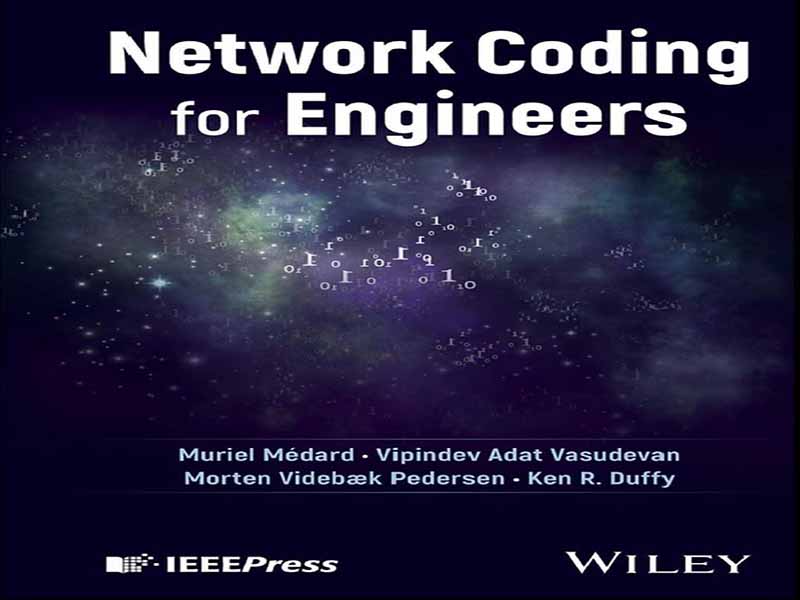- عنوان: Network Coding for Engineers
- نویسنده: Muriel Médard
- حوزه: تحلیل ترافیک شبکه
- سال انتشار: 2025
- تعداد صفحه: 261
- زبان اصلی: انگلیسی
- نوع فایل: pdf
- حجم فایل: 4.49 مگابایت
هدف شبکههای بستهای، مانند اینترنت، انتقال مطمئن اطلاعات از منابع به گیرندهها است. در حالی که دادهها برای ارتباط بستهبندی میشوند، که ممکن است شامل فشردهسازی آن و اضافه کردن هدرهایی باشد که مقصدها و همچنین سایر اطلاعات را توصیف میکنند، به طور سنتی خود جریانهای داده در حین عبور از شبکه تغییرناپذیر تلقی میشوند، به این معنا که اطلاعات جریانهای منفرد در طول انتقال آنها جداگانه و دست نخورده نگه داشته میشوند. فرضیه ساده کدگذاری شبکه (NC) این است که دادهها را میتوان به راحتی به صورت جبری دستکاری کرد و استفاده از این واقعیت منجر به کاهش بسیاری از مشکلات شبکه میشود که میتوان از آن برای بهبود چشمگیر عملکرد در تعدادی از ابعاد متمایز استفاده کرد. به عنوان یک آزمایش فکری اساسی، اگر شبکه بخواهد دو قطعه اطلاعات، A و B، را منتقل کند، میتواند به جای آن A و A + B را منتقل کند و به گیرنده اجازه دهد تا یک مجموعه اساسی از معادلات خطی، یعنی B = (A + B) – A را حل کند تا هر دو را بازیابی کند. چرا این مفید خواهد بود؟ به موقعیتی فکر کنید که در آن سه بسته از طریق یک شبکه منتقل میشوند، اما یکی از آنها در حین انتقال گم میشود، همانطور که در شبکههایی مانند اینترنت میتواند اتفاق بیفتد. اگر شبکه A، B و A + B را ارسال کند، مهم نیست کدام دو بسته از آن عبور کنند، گیرنده میتواند دادههای اصلی را بازسازی کند. تعمیم و بهرهبرداری از این اصل ساده، همانطور که خواهیم دید، منجر به دستاوردهای بزرگ و عملاً قابل دستیابی در عملکرد میشود. کدگذاری شبکه خطی تصادفی (RLNC) تا زمان ظهور کدگذاری شبکه خطی تصادفی (RLNC) در حوزه نظریه اطلاعات محض باقی ماند. این کدگذاری از جمعهای ساده مدول دو بسته به ایجاد ترکیبات خطی از چندین بسته در یک میدان محدود و مخابره نتیجه دیجیتال تکامل یافته است، زیرا انجام این کار باعث بهبود قابل توجه در کارایی پهنای باند شبکهها میشود. RLNC ذاتاً باعث ایجاد استحکام و سازگاری در محیطهای پویا میشود. RLNC برای محیطهای توزیعشده و پویا مانند شبکههای بیسیم مناسب بوده است. شبکههای آینده، مانند محیطهای سلولی کوچک که دارای ارتباط دستگاه به دستگاه (D2D) و همکاری بین دستگاهها هستند، باید اطمینان حاصل کنند که به هر کاربر در شبکه به طور منصفانه خدمات ارائه میشود، جایی که معیارهای متمایز مربوط به کیفیت خدمات، مانند توان عملیاتی، تأخیر و تأخیر، باید رعایت شوند. در محیطهای مشارکتی، RLNC میتواند به حد بالایی از کارایی در پخش چندگانه دست یابد. RLNC به عنوان یک راه حل عملی در این تنظیمات ایجاد شده است که میتواند توان عملیاتی و قابلیت اطمینان بالاتری را با تأخیر کمتر بر روی زیرساختهای شبکه غیرقابل اعتماد فراهم کند. یکی از ویژگیهای کلیدی RLNC این است که به لطف سازگاری با پروتکلهای موجود و قابلیت پیادهسازی آن هم در نرمافزار و هم در سختافزار، میتوان آن را به راحتی در سیستمهای قدیمی ادغام کرد. در حالی که RLNC با ارسال بستههای کدگذاری شده از طریق کانالهای مختلف به دنبال دستیابی به کارایی بهینه از نظر استفاده از پهنای باند است، به طور طبیعی تصحیح پاک شدن را نیز فراهم میکند و در برابر حملات مرد میانی مقاومت ایجاد میکند. در حالی که استفاده از NC به خودی خود تنها محافظتهای ضعیفی را ارائه میدهد، به طور گسترده مورد مطالعه قرار گرفته است که چگونه با کمی تقویت، میتوان از مزایای بیشتری مانند افزایش امنیت و حفاظت از حریم خصوصی با استفاده از RLNC در دوران چالشبرانگیز محاسبات کوانتومی پیش رو بهره برد. در جهانی با افزایش تقاضا در جبهههای مختلف، بازنگری در پروتکلهای ارتباطی ضروری میشود و RLNC پیش از این ثابت شده است که راهی پیش رو است. پذیرندگان مختلف صنعتی در حال حاضر از اصول کدگذاری بهرهمند میشوند و از RLNC در کاربردهای متنوعی استفاده میکنند. این فناوری راه خود را به استانداردها و استقرارهای صنعتی، مطابق با تحقیقات نظری قابل توجهی که در چند دهه اخیر پیرامون این موضوع انجام شده است، پیدا کرده است. منابع زیادی وجود داشته است، نه تنها تعداد زیادی مقاله منتشر شده در کنفرانسها و مجلات معتبر، بلکه کتابهای بزرگی که ابعاد مختلف RLNC را در ادبیات معرفی میکنند. با این حال، کتاب درسی که به تطبیق NC از نتایج عالی آن در ادبیات با راهحلهای مهندسی کمک کند، هنوز محقق نشده است. این کتاب سعی دارد شکاف بین پیشرفتهای دانشگاهی در حوزه NC و تحقق عملی آن را از یک دیدگاه مهندسی کامل پر کند.
The objective of packet networks, such as the Internet, is to reliably transport information from sources to receivers.While data is packaged for communication, which may involve compressing it and adding headers describing destinations as well as other information, traditionally the data streams themselves are treated as immutable as they traverse the network, in the sense that the information of individual streams is kept separate and intact throughout their transit. The simple premise of Network Coding (NC) is that data can be readily algebraically manipulated and that making use of that fact results in a relaxation of many networking problems, which can be leveraged to vastly improve performance in a number of distinct dimensions. As a basic thought experiment, if the network wishes to transport two pieces of information, A and B, it could instead transport A and A + B and allow the receiver to solve a basic set of linear equations, i.e. B = (A + B) − A, to recover both. Why would that be useful? Think of a setting where three packets are transmitted across a network, but one will get lost in transit, as can happen in networks such as the Internet. If the network transmits A, B, and A + B, no matter which two packets get through, the receiver can reconstruct the original data. The generalization and exploitation of this simple principle results in large, practically achievable gains in performance, as we shall see. NC remained in the realm of pure information theory until the advent of Random Linear Network Coding (RLNC). It has evolved from simple modulo additions of two packets to creating linear combinations of multiple packets in a finite field and communicating the digital result as doing so enables significant improvement in the bandwidth efficiency of networks. RLNC inherently generates robustness and adaptability in dynamic environments. RLNC has proven suitable for distributed, dynamic environments such as wireless networks. Future networks, such as small cell environments featuring Device-to-Device (D2D) communication and cooperation between devices, will have to ensure that every user in the network is fairly provided with services, where distinct metrics concerning the quality of service, such as throughput, delay, and latency, all have to be met. In cooperative environments, RLNC can achieve the upper bound of efficiency in multicasting. RLNC has been established to be a practical solution in these settings that can provide higher throughput and reliability with lower latency over unreliable network infrastructure. A key feature of RLNC is that it can be readily integrated into legacy systems, thanks to its compatibility with existing protocols and its ability to be implemented both in software as well as hardware. While RLNC seeks to achieve optimum efficiency in terms of bandwidth usage by sending coded packets over different channels, it also naturally provides erasure correction and imparts resistance to man-in-the-middle attacks. While the use of NC by itself provides only weak protections security, it has been extensively studied how, with some augmentation, it is possible to harness more benefits such as increased security and privacy protection using RLNC in the challenging, quantum computing times ahead. In aworld with increasing demands onmultiple fronts, it becomes a necessity to re-envision communication protocols and RLNC has already been proven to be a way ahead. Different industrial adopters are already benefiting from coding principles and use RLNC in a variety of applications. It has found its way to standards and industrial deployments in line with the significant theoretical research that has been happening around the topic in the last couple of decades. There have been great resources, not only the large number of papers published in reputed conferences and journals but also great books introducing different dimensions of RLNC in the literature. However, a textbook that assists the adaptation of NC from its excellent results in the literature to engineering solutions has notmaterialized. This book tries to bridge the gap between the academic advancements in the area of NC to its practical realizations, from a complete engineering perspective.
این کتاب را میتوانید بصورت رایگان از لینک زیر دانلود نمایید.
Download: Network Coding for Engineers



































نظرات کاربران